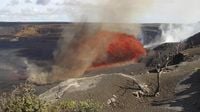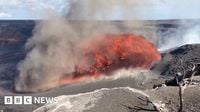The Kīlauea volcano, nestled within Hawaii Volcanoes National Park on the Big Island, once again captured the attention of scientists, locals, and awe-struck visitors as it erupted for the 31st time since December 2024. This latest episode, which began on the afternoon of August 22, 2025, was marked by a dramatic display of nature’s power: lava fountains soared up to 325 feet (100 meters) into the air, plumes of white smoke billowed above the Halemaʻumaʻu crater, and molten rock spilled across more than three-quarters of the crater floor.
According to the U.S. Geological Survey (USGS), the eruption commenced with continuous spattering from the north vent at approximately 8:30 a.m. HST. By late morning, the intensity had grown, culminating in sustained overflows and the formation of a new cone inside the north vent. The eruption’s crescendo arrived in the afternoon, when the north vent began to shoot lava fountains skyward, drawing comparisons to a "roaring jet engine or crashing ocean waves," as described by Janice Wei, a Park Service volunteer and frequent observer of Kīlauea’s fiery performances (NPR).
"Every eruption feels like I am sitting in the front row at nature's most extraordinary show," Wei wrote in an email, capturing the sense of wonder that has drawn both residents and tourists to the park in increasing numbers. In fact, park visitation has climbed every month in 2025 so far, with April alone seeing a 49% increase compared to the previous year (NPR).
The 31st eruptive episode, as detailed by the USGS Hawaiian Volcano Observatory, lasted approximately 12.6 hours and ended abruptly at 2:52 a.m. HST on August 23. The north vent, which had dominated the eruption with its towering fountains, ceased activity at that moment, while the south and intermediate vents had already gone quiet earlier in the night. During the fountaining phase, an estimated 10,900,000 cubic yards (8,400,000 cubic meters) of lava were ejected at an average rate of 240 cubic yards per second (185 cubic meters per second). The resulting flows covered more than 75% of the Halemaʻumaʻu crater floor within the southern part of Kaluapele, and may continue to glow or move slowly as they cool in the coming days (Big Island Video News).
The eruption was entirely contained within the summit crater, and no homes or communities were threatened. All recent volcanic activity has occurred within the boundaries of Hawaii Volcanoes National Park. As a result, the USGS Volcano Alert Level and Aviation Color Code for Kīlauea remain at WATCH/ORANGE, indicating that the situation is being closely monitored but does not currently pose a broader risk (Big Island Video News).
Scientifically, the ongoing activity at Kīlauea offers a fascinating glimpse into the inner workings of one of the world’s most active volcanoes. Ken Hon, scientist-in-charge at the Hawaiian Volcano Observatory, explained to NPR that magma is being supplied directly from the Earth’s interior into a lower chamber beneath Halemaʻumaʻu at a rate of about 5 cubic yards (3.8 cubic meters) per second. This influx inflates the chamber, eventually forcing magma into an upper chamber, and from there, pressure builds until it erupts to the surface through narrow, pipelike vents. The explosive nature of these fountains is likened to a Champagne bottle being uncorked after a vigorous shake—pent-up gases propel the magma skyward in spectacular arcs.
This pattern of episodic lava fountaining is not new to Kīlauea. Similar sequences were recorded in 1959, 1969, and during the 1983-2018 eruption, which saw 44 such episodes over three years. However, the current cycle has unfolded in a location more accessible to the public, offering a rare front-row seat to volcanic drama (NPR).
Despite the frequency and intensity of these eruptions, scientists remain cautious in their predictions. As Ken Hon put it, "Our job is like being a bunch of ants crawling on an elephant trying to figure out how the elephant works." While sensors tracking earthquakes and subtle shifts in ground tilt can offer a few days’ warning before an eruption, the long-term evolution of Kīlauea’s activity remains uncertain. The vent’s widening in recent episodes may be leading to shorter, broader fountains, according to Steve Lundblad, a geology professor at the University of Hawaii at Hilo. "We're still gonna have spectacular eruptions," he noted. "They're just going to be wider and not as high."
The cultural significance of Kīlauea’s eruptions runs deep among Native Hawaiians. Halemaʻumaʻu crater is revered as the home of Pele, the volcano goddess. Huihui Kanahele-Mossman, executive director of the Edith Kanakaʻole Foundation, shared that witnessing the eruptions firsthand is both a spiritual and educational experience. "You as the dancer, you are the storyteller and you carry that history that was written in those mele forward," she said, referring to the Hawaiian word for song. Kanahele-Mossman often visits the crater to observe the eruption, compare it to ancient chants, and offer traditional gifts such as awa and fern lei, underscoring the living connection between the land, its stories, and its people (NPR).
For visitors, the eruption is both a spectacle and a reminder of nature’s hazards. Park spokesperson Jessica Ferracane emphasized the importance of caution, urging guests to stay on marked trails and overlooks. Unstable cliffs, cracks, and the presence of volcanic gases, glass, and ash present real dangers, particularly for young children and nighttime visitors. "The eruption could be over before you know it," Ferracane warned, recommending that would-be spectators sign up for USGS alerts to avoid disappointment or risk (NPR).
Volcanic gas emissions decreased significantly after the latest episode ended, and seismic activity at the summit shifted from deflation to inflation, signaling a pause in eruptive behavior. No changes were detected in the East Rift Zone or Southwest Rift Zone, and the overall volcanic alert status remains unchanged (Big Island Video News).
As the lava cools and the glow fades, scientists, cultural practitioners, and park visitors alike are left reflecting on the forces that shape Hawaii’s landscape. For some, it is a reminder of the island’s ever-changing nature; for others, it is a living link to centuries-old traditions and stories. And for all, Kīlauea’s eruptions remain a powerful testament to the restless energy beneath our feet—an extraordinary show that, even after 31 episodes, never fails to inspire wonder.





